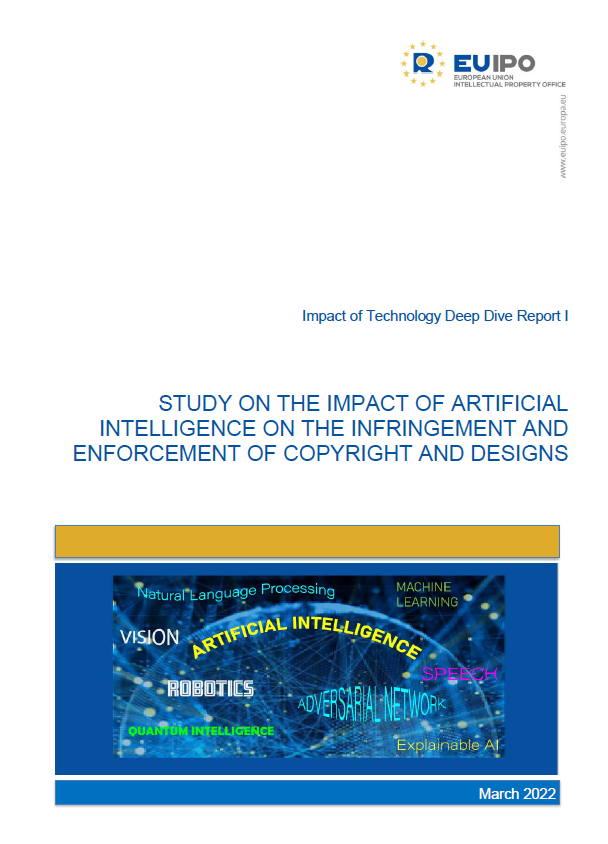“The Report concludes that AI can improve efficiency in detecting and enforcing copyright and design infringements, but that use of AI technologies for criminal purposes (including copyright and design infringement) is increasing.”
 The European Intellectual Property Office (EUIPO) recently published a deep dive report, titled Study on the Impact of Artificial Intelligence on the Infringement and Enforcement of Copyright and Designs.
The European Intellectual Property Office (EUIPO) recently published a deep dive report, titled Study on the Impact of Artificial Intelligence on the Infringement and Enforcement of Copyright and Designs.
The report is a product of the Impact of Technology Expert Group, which was established in early 2019. They followed an approach based on Lawrence Lessig’s ‘Code and Other Laws of Cyberspace’ also known as the Code Theory. This describes how human online activity is regulated by law, social norms, and the market, taking into consideration the internet’s technical infrastructure.
This approach led to a double-edged sword metaphor, in which a particular technology can be used either to infringe IP rights or to protect/enforce them, presenting to some extent the same features in each case.
The Group also developed a methodology called the Intellectual Property Tech Chain, which was described in its first report, published in September 2020. According to this methodology, the development of any application follows four steps: Exploration; Conversion; Weaponization; and Utilization.
The report does not specifically address other types of IP, nor does it address substantive issues related to protection, examination of applications, documentation, rights management or ownership of copyright and designs.
Findings of the Report
The report considers the use of AI technologies and tools in copyright and design infringement and enforcement in 20 scenarios. These 20 scenarios are grouped into two storylines – physical products and digital content.
The first storyline includes scenarios such as: theft of copyrightable work or design under development; mass production of copyright and design-infringing goods; physical market sale of copyright and design-infringing products; trade dress infringement; and online marketing of copyright and design-infringing products
The second storyline includes: hacking media accounts; social media offences; media-sharing platform offences; P2P and BitTorrent-like applications; livestreaming; and training an AI application.
The Report concludes that AI can improve efficiency in detecting and enforcing copyright and design infringements, but that use of AI technologies for criminal purposes (including copyright and design infringement) is increasing.
Limitations of AI in this sphere include dependence on a large amount of high-quality data, inability to deal with long-tail problems, limited versatility, dependence on specific application scenarios, limited actual use by law enforcement agencies in copyright and design enforcement. Concerns include those related to ethics, privacy and fundamental rights.
Recommendations and Conclusions
The report endorses the view of the European Parliament that algorithms and AI should be ‘ethical by design’ and the need to find a common complementary legal and ethical framework for the use of AI.
There is a proposed new EU regulatory framework for AI which is intended to ensure that AI systems used in the E.U market are safe and respect existing law on fundamental rights and values. This is now being discussed. (See ‘A European approach to artificial intelligence’.)
The report concludes: “A wide range of AI-related tools and technologies are currently or potentially in use in copyright and design infringement and enforcement. There is clearly a need for better understanding, increased awareness and enhanced capacities on the part of all stakeholders, including policymakers, IP protection entities, companies and law enforcement authorities.”

![[IPWatchdog Logo]](https://ipwatchdog.com/wp-content/themes/IPWatchdog%20-%202023/assets/images/temp/logo-small@2x.png)

![[Advertisement]](https://ipwatchdog.com/wp-content/uploads/2024/04/Patent-Litigation-Masters-2024-sidebar-early-bird-ends-Apr-21-last-chance-700x500-1.jpg)

![[Advertisement]](https://ipwatchdog.com/wp-content/uploads/2021/12/WEBINAR-336-x-280-px.png)
![[Advertisement]](https://ipwatchdog.com/wp-content/uploads/2021/12/2021-Patent-Practice-on-Demand-recorded-Feb-2021-336-x-280.jpg)
![[Advertisement]](https://ipwatchdog.com/wp-content/uploads/2021/12/Ad-4-The-Invent-Patent-System™.png)







Join the Discussion
2 comments so far.
Anon
March 25, 2022 08:29 amAnother example of a double-edged sword:
https://www.sciencealert.com/ai-experiment-generated-40-000-hypothetical-bioweapons-in-6-hours-scientists-warn/amp
Anon
March 24, 2022 07:50 pmWhy presume that Lawrence Lessig’s approach is correct, let alone the only approach to be used for such a contentious innovation space?